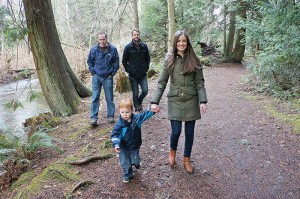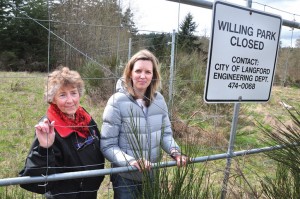posted by admin on Dec 14
Date: Fri, 4 Dec 2009 14:58:20 -0800
To: planning@cityoflangford.ca
From: Deb Harper <Deb@HomeGrow.ca>
Subject: Langford Bylaw 1262
To City Planning:
I am writing in regards to Bylaw 1262
a) Planning, Zoning & Affordable Housing Committee – November 9′”, 2009 14
1. Rezoning Application – 3324, 3328, 3348 & 3352 Hazelwood Road and 1024 Englewood Ave (Application to Rezone from AGI [Agriculture 1] and R2A [One and Two Family Residential] to a new Comprehensive Development zone to allow for the development of approximately 65 residential lots (File No. Z -09-16)
——————————————–
I was unaware of this zoning proposal until recently when I decided to walk down Hazelwood Rd. instead of my usual route on the Galloping Goose and saw the sign. Truthfully, it is very difficult to keep up with the speed of the rezoning proposals that come forward.
The traditional layout of this neighbourhood is well suited for being situated on a flood plain. (http://bilstoncreek.org/floods.htm) If/when the floods come, (and they always will), very few homes are affected, and the agricultural land is not affected, and at best, it helps prepare it for the dry summer ahead.
The more I learn about food security, the more I know how extremely fortunate Langford is to have agricultural land and neighbourhoods like Hazelwood, and how important it is to save them from becoming some generic suburb that could be anywhere in North America.
This unique, old neighbourhood can be preserved and with support from the city, as per the Langford Agricultural Strategy, make parts of the yards into productive food gardens. This would bring more families closer to becoming self-sustaining, and add further produce to the Farmers Market.
It could also be showcased to the world, to highlight a city with great vision and foresight, that realized the true value in having and retaining such places as the Hazelwood neighbourhood and it’s agricultural lands in the ALR. When the situation soon arises, and communities need to rely more on their own resources to produce food, Langford could be among the “haves”, not a “have not” like all the other cities.
I am not anti-development because development and growth can be parsed various ways. The main core surrounding downtown is the most practical and logical place to develop for housing and density by adding high rises and multi-family units to that corridor rather than outlying areas. – The main roadway and public transportation corridor is in this area – It is already developed and not agricultural land. – It is easy to walk to amenities – pedestrian friendly
In contrast, South Langford lacks road infrastructure, amenities, good public transportation, no bus shelters and claws away more scarce agricultural land. The long run costs to the city in terms of services and infrastructure needed, will outweigh the short run financial benefits, not to mention the new social costs that arise with increased density.
A one acre organic micro-farm has the potential to generate a $40,000 income while maintaining the land’s fertility. (http://www.new-terra-natural-food.com/micro-farming-for-profit.html )
Landowners producing food and value-added products and services can begin right now and generate money for the local economy year after year with stable, real sustainable, local employment for those involved. The low density also mean no further infrastructure, services or increase of flood damage claims. How is that not a win-win situation?
Various groups of citizens are organizing in response to Langford Agricultural Strategy to work with the city, other regions, and organizations, on many of the issues outlined in the Strategy. Alternate plans that include developing a strong agricultural sector in the local economy could be more beneficial to the city and citizens over the long run, and a chance should be given to compile and present the data. (In development: http://greenlangford.ca/)
It would make a great deal of sense to place a moratorium on any further housing development in these low density / agricultural/Greenbelt lands until there is chance for this report to be discussed by interested local residents. It would be a great show of faith and commitment on the city’s part that it is taking the Langford Agricultural Strategy seriously.
Regards, Deb Harper
http://homegrow.ca/
Date: Fri, 4 Dec 2009 14:58:20 -0800
To: planning@cityoflangford.ca
From: Deb Harper
Subject: Langford Bylaw 1262
To City Planning:
I am writing in regards to Bylaw 1262
a) Planning, Zoning & Affordable Housing Committee – November 9′”, 2009 14
1. Rezoning Application – 3324, 3328, 3348 & 3352 Hazelwood Road and 1024 Englewood Ave (Application to Rezone from AGI [Agriculture 1] and R2A [One and Two Family Residential] to a new Comprehensive Development zone to allow for the development of approximately 65 residential lots (File No. Z -09-16)
——————————————–
I was unaware of this zoning proposal until recently when I decided to walk down Hazelwood Rd. instead of my usual route on the Galloping Goose and saw the sign. Truthfully, it is very difficult to keep up with the speed of the rezoning proposals that come forward.
The traditional layout of this neighbourhood is well suited for being situated on a flood plain. (http://bilstoncreek.org/floods.htm) If/when the floods come, (and they always will), very few homes are affected, and the agricultural land is not affected, and at best, it helps prepare it for the dry summer ahead.
The more I learn about food security, the more I know how extremely fortunate Langford is to have agricultural land and neighbourhoods like Hazelwood, and how important it is to save them from becoming some generic suburb that could be anywhere in North America.
This unique, old neighbourhood can be preserved and with support from the city, as per the Langford Agricultural Strategy, make parts of the yards into productive food gardens. This would bring more families closer to becoming self-sustaining, and add further produce to the Farmers Market.
It could also be showcased to the world, to highlight a city with great vision and foresight, that realized the true value in having and retaining such places as the Hazelwood neighbourhood and it’s agricultural lands in the ALR. When the situation soon arises, and communities need to rely more on their own resources to produce food, Langford could be among the “haves”, not a “have not” like all the other cities.
I am not anti-development because development and growth can be parsed various ways. The main core surrounding downtown is the most practical and logical place to develop for housing and density by adding high rises and multi-family units to that corridor rather than outlying areas. – The main roadway and public transportation corridor is in this area – It is already developed and not agricultural land. – It is easy to walk to amenities – pedestrian friendly
In contrast, South Langford lacks road infrastructure, amenities, good public transportation, no bus shelters and claws away more scarce agricultural land. The long run costs to the city in terms of services and infrastructure needed, will outweigh the short run financial benefits, not to mention the new social costs that arise with increased density.
A one acre organic micro-farm has the potential to generate a $40,000 income while maintaining the land’s fertility. (http://www.new-terra-natural-food.com/micro-farming-for-profit.html )
Landowners producing food and value-added products and services can begin right now and generate money for the local economy year after year with stable, real sustainable, local employment for those involved. The low density also mean no further infrastructure, services or increase of flood damage claims. How is that not a win-win situation?
Various groups of citizens are organizing in response to Langford Agricultural Strategy to work with the city, other regions, and organizations, on many of the issues outlined in the Strategy. Alternate plans that include developing a strong agricultural sector in the local economy could be more beneficial to the city and citizens over the long run, and a chance should be given to compile and present the data. (In development: http://greenlangford.ca/)
It would make a great deal of sense to place a moratorium on any further housing development in these low density / agricultural/Greenbelt lands until there is chance for this report to be discussed by interested local residents. It would be a great show of faith and commitment on the city’s part that it is taking the Langford Agricultural Strategy seriously.
Regards, Deb Harper
http://homegrow.ca/

